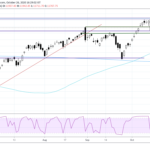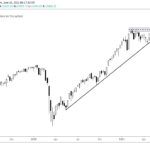So you’re looking to find a foolproof investment strategy.
How about the strategy which will continue to work forever?
I am going to let you in on a secret!
Are you ready to learn the secret?
Here we go…

…there’s no secret ingredient! It’s just you!!!
Okay! I borrowed that line from the movie Kung Fu Panda! But the message aptly applies to both trading & investing!
A foolproof trading strategy is the one that you’ll be able to follow for the long term.
There are no right or wrong answers but only what is right for you!
Now, before you throw a brick at me, let me try & explain what I mean!
Let’s add a little filmy flavor and compare the two successful directors, Rohit Shetty and Raju Hirani to understand what I mean.

Both are highly successful filmmakers but both have different approaches to film making.
Rohit Shetty provides what people want and churns out a couple of movies every year. The movies are at best” Masala” types & not much content heavy.
But that’s what most people are looking for in India and he has been successful in providing just that.
On the other hand, for Raju Hirani, the content and the script of the movie is extremely important. He can wait for a couple of years for the right script, story & content to amplify his creative pursuits.
Once he has a good story in hand, he will probably spend another year or so to make the movie and spend huge money on the project.
Now, if the movie is a hit, he will reap huge rewards and everybody’s happy!
But what if the movie fails?
He can lose a lot of money & time and will have to again wait for a couple of years to recoup the losses!
In the case of Rohit Shetty, there can be a series of movies that can fail but it won’t make much of an impact on him because his movies are made on a relatively tight budget.
The other thing is that the law of large numbers is in Rohit Shetty’s favor as he makes more number of movies than Raj Kumar Hirani. One or two good movies and he’ll recover his losses!
What has this got to do with investments?
Rohit Shetty is like a typical trend follower and he will focus on what’s working & make movies according to that. He will control his losses as the movies are made on a relatively small budget compared to Raju Hirani. Shetty will also make more number of movies so that the losses are recovered quickly.
While Raju Hirani’s approach to filmmaking is akin to Warren Buffett’s approach to investing, more or less.
Mr. Buffett is willing to wait years for the right investment opportunity and bet huge when the opportunity comes around.
If there are no lucrative opportunities, he’ll sit on cash!
The last time I checked, he was sitting on a cash pile of around $140 B.
That’s a billion with a B!
Now the question you have to ask yourself is, am I willing to sit on cash for the next couple of months if not years to find the right opportunities?
Sitting on cash & doing nothing is extremely difficult for most retail traders and investors.
Ask me!
I was sitting on cash from April 2020 till June 2020 as my regime filter had signaled to stay out of the markets. And to my horror, markets had been rising.
Believe me, that’s very hard!
But that’s where the systematic, rule-based investing comes into play!
So which is a foolproof investment strategy?
Value investing, Growth investing, Trend following, Momentum, Mean reversion?
Well, there are successful examples in all of these camps!
All are valid approaches and can work!
So the best investment strategy is the one which works for you!
For me, it’s Quantamentals & Mean Reversion combined!
You’ll have to decide for yourself.
How do you find the foolproof investment strategy which can work for you?
The following are general guidelines you can use to find the most suitable investment strategy that works for you.
1. Beliefs:
You don’t trade markets. You trade your beliefs about the market!
Van K Tharp
What are your beliefs about the markets, investments money, etc?
Let’s analyze the following statements…
You can make a lot of money from the market!
Investing in the stock market is gambling!
Now, both of the above beliefs can be true if you believe them to be. But the second belief is not very useful to you when it comes to investing in stock markets. If you see markets as a casino, you’ll probably never bother to find out how to really make money.
If you list down your major beliefs, it will give you more ideas about what you want to trade, how you want to trade, etc. You will also be able to see and discard non-useful beliefs like the above.
Here’s what I believe…
- Momentum Investing works.
- Mean reversion works over the short term.
- Markets can be timed.
- Markets can be beaten.
- Buy and Hold is dead!
- Buy low and sell higher is a loser’s game.
- One can only make money with a rule-based systematic approach.
- You cannot compound your money by short-term trading.
- You don’t need highly sophisticated algorithms to make money. Simple systems can be very effective.
- Day trading is a waste of time.
- Trading for a living is a myth.
These are my beliefs which may not be necessarily true for you.
Keeping the above beliefs in mind I trade rule-based momentum & mean reversion strategies.
2. Objectives:
What are you trying to achieve by trading in the markets?
Is it that you want to generate an additional income along with your job or business?
Is it that you want to grow your wealth over the long term? OR,
Are you looking to diversify your investments?
Are you looking to day trade for a living?
My objective is to beat buy & hold with less risk, time & stress by diversifying into multiple low correlated strategies.
What’s yours?
3. Investment Capital:
Let’s say, your objective is to trade for a living.
Fair enough!
How much do you need to make to cover living expenses and some more?
I think 3 lakh is a reasonable estimate.
How much capital do you have?
Say, Rs. 3 lakh. Most traders don’t even have this much.
That means you need to make 100% every year. Unbelievable if not impossible!
Anyways, how much can you lose?
The drawdowns in the range of 20-30% are quite common and generally a reward to risk ratio of 2:1 is great if not exceptional! Therefore, to make 100% returns, you’ll need to take on a higher risk of around 50% of your capital.
Can you tolerate losing 1.5 lakh out of 3 lakhs to earn 3 lakhs?
If you can you’re one among a million if not billion!
If you can’t, then you’ll have to pare down your return expectations. But that will not help you achieve your objective of earning Rs. 3 lakh.
Therefore, you’ll need larger investment capital.
As an example, what if you have Rs. 10 lakh as investment capital? Now, the reward to risk is absolutely justified and achievable.
This is a big issue with beginners and retail investors! Most of them are undercapitalized. No wonder why so many investors lose money following the advice from the tipsters!
Your investment capital along with proper position sizing will determine whether you can achieve you’re objectives or not.
That’s why I promote professional part-time trading along with your job or business!
That’s a sure way to financial freedom!
I encourage you to read my article on trading for a living!
4. Time & circumstances:
If you’re a busy professional or businessmen, you’ll not be able to day trade effectively.
If you have family commitments, you will be required to be conservative with your capital.
You get the point!
5. Knowledge & Skills:
What skills do you have?
Are you proficient in programming or math skills?
How are your research skills be it fundamental, technical, or quantitative?
How much market experience do you have?
6. Discretionary or Systematic:
Are you going to trade based on discretion or 100% systematic? If you are going to use both ways, how much will you allow discretion in your trading, and under what circumstances?
I use 100% mechanical trading systems but I allow for some discretion as to overall portfolio exposure and position size.
In the month of October, I have already raised the cash in my Dual Momentum portfolio anticipating higher volatility over the next few months.
I vary the position sizing based on market conditions but the entry and exit rules are always followed to the T.
Conclusion:
These are not exhaustive but most important guidelines for you.
So rather than spending time looking for a foolproof investing approach, it’s better to focus on your beliefs, circumstances, capital, time, knowledge, and most importantly your objectives!
Then you can pick any trading or investing approach which is aligned to your objectives.
If you’re interested in learning how to combine momentum with mean reversion, check out my Hybrid Strategy.
All the best!








Great reading! It make sense.
Thanks for the feedback 🙂